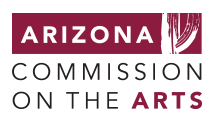The Arizona Commission on the Arts is currently accepting applications for Artist Research and Development Grants (ARDG). This month we are speaking with 2015’s ARDG recipients in series called Perspectives. Today we speak with Geneva Foster Gluck of Tucson, AZ.
Geneva Foster Gluck began her training in fine art, dance and athletic-circus performance. In 1998 while completing her BFA at University of Arizona, Gluck became a core member of Tucson-based Flam Chen Pyrotechnic Theatre, where she introduced aerial circus skills and interactive sculpture into the company’s performance repertoire.
After Gluck earned her M.A. in Scenography at the University of London in 2003, she went on to work with some of the UK’s most successful contemporary and immersive theatre companies. In 2007 she established Sugar Beast Circus, an interdisciplinary performance company with the aim of integrating contemporary circus, new technology and research driven narratives. Sugar Beast Circus has participated in numerous artist residencies, funding awards and festival programing across Europe. In 2012 Gluck returned to Arizona to engage in research around the West.
Currently Gluck teaches Theatre Design classes at Pima Community College.
In January 2015, Gluck was awarded an Artist Research and Development Grant from the Arizona Commission on the Arts in support of development and production of Geometry of the West, an ambitious fusion of oral history, interactive installation art, theatre, circus and dance.
The first performances of Geometry of the West were presented in July 2015 in Tucson. Recently, Gluck spoke with us about subverting Western clichés, using design to explore difficult subjects, and what’s next for this unique production.
How did Geometry of the West begin?
I wanted to start by collecting true narrative accounts of the West from the many voices and perspectives missing from Hollywood westerns.
I received a grant from the Tucson Pima Arts Council to build an audio recording structure that would eventually become the centerpiece of the show, Geometry of the West. The structure is a 6’ x 6’ steel and wood cube that I designed to be a listening station and a mobile recording unit: headphones hang outside of the box so you can hear previously recorded narratives, and when you walk inside there’s a chair, a microphone, and a recording device so you can tell your story.
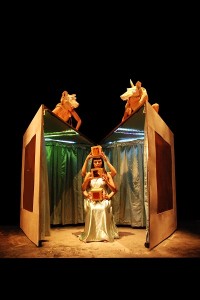 Geometry of the West, the performance, comes from the collection of all those stories. Listening to them, I could tell, “Oh, this is a very young person. This is an old person. This person feels very serious about the story they’re telling, and maybe this person is making the story up as they’re telling it.” Often the shortest, weirdest statements took on the biggest meaning when translating the audio to the stage show. In one of the recordings, someone says, “Well, in the heat of the summer, in the desert, it’s the only place where ghosts haunt in the daytime.” It was just a snippet of a story, but it resonated with me as explaining what the desert is and inspired a huge scene.
Geometry of the West, the performance, comes from the collection of all those stories. Listening to them, I could tell, “Oh, this is a very young person. This is an old person. This person feels very serious about the story they’re telling, and maybe this person is making the story up as they’re telling it.” Often the shortest, weirdest statements took on the biggest meaning when translating the audio to the stage show. In one of the recordings, someone says, “Well, in the heat of the summer, in the desert, it’s the only place where ghosts haunt in the daytime.” It was just a snippet of a story, but it resonated with me as explaining what the desert is and inspired a huge scene.
Many of the stories were these “the cowboy killed them, and there was a sheriff and he killed them, and the killing, and the killing….” I didn’t choose any one of those stories, but it became a very big motif. So in the show, the cowboys are limited in their actions and they just shoot each other. They appear, something happens and they kill each other. They appear, something happens and they kill each other. That’s their loop.
Can you tell us about some of the other characters?
There’s another character that represents time; this character starts with gold, then becomes fascinated with silver, then there’s a copper experience, then it goes back to the sand. There is also the woman who is maybe the protagonist of the story. She is stuck in the middle of the violence of the cowboys and this process of time. She is like the audience in the way she is observing these two forces that seem to be at play in the west, these two forces changing the landscape, changing the culture, changing the way we live our lives, changing our interactions. And there are coyotes, perhaps it is the woman shape shifting or maybe it’s the elements becoming active, but the coyote as trickster/truth teller is the fourth character in the piece.
And so even though you aren’t using the stories directly, you are using the 6’x6′ box as a central stage piece. How does the box function in the show?
 The show takes place inside the box, outside the box, on top of the box, behind the box. It has a doorway built into it, it can collapse down, or open up into two triangles; it rotates and forces action to happen in a different way. The box was designed to have something of an old magic illusion: we’re working with the Perspex/Plexiglas and lighting it either internally or externally to make it either translucent or opaque throughout the show. It might function as a projection screen while allowing for hidden changes inside of it: costume changes, set changes, lighting changes. The box reflects one of the main points of inspiration for the show– the idea of things transforming. It allows that idea to exist just by the nature of the material, which is part of what I aim for in my designs. The box acts as a scenographic element and tells a story, but it also has a practical staging role.
The show takes place inside the box, outside the box, on top of the box, behind the box. It has a doorway built into it, it can collapse down, or open up into two triangles; it rotates and forces action to happen in a different way. The box was designed to have something of an old magic illusion: we’re working with the Perspex/Plexiglas and lighting it either internally or externally to make it either translucent or opaque throughout the show. It might function as a projection screen while allowing for hidden changes inside of it: costume changes, set changes, lighting changes. The box reflects one of the main points of inspiration for the show– the idea of things transforming. It allows that idea to exist just by the nature of the material, which is part of what I aim for in my designs. The box acts as a scenographic element and tells a story, but it also has a practical staging role.
So, how would you describe Geometry of the West?
Structurally, I think dance-theater is a good term for it: in the way that Pina Bausch might set up a space and explore it through movement, but there is still a story that would unfold. There is a storyline in Geometry of the West, but it’s not a traditional play of beginning-middle-and-end. It’s more about the patterns of narratives that happen within the archetypes of the West, the cycles of character experience, how those cycles interact and the geometry of actions and reactions.
As far as the tone, the work is not taking itself too seriously, there is humor, and there are these beautiful, intricate, strange moments where the set is moving, and the lights are moving, and the performers are doing something that looks familiar, but is also very strange and new. Surreal is such an overused word, maybe they are sort of Lynchian moments. David Lynch’s work is surreal, but he’s so contemporary and just slightly “off,” or out of sync with what you’d expect. There’s a slippage or strangeness that ultimately unifies the piece and makes it… not surreal, not dreamscape… but definitely not reality. Something in-between.
And how does Geometry of the West reframe the western?
I watched a western recently, and it was very much like most westerns are: there’s this man, and he’s heroic, and we just want to watch him kill people (or I guess that’s what we are supposed to want from the movie?). Geometry of the West, on the other hand, is performed by three women who rotate through all the characters. We’re all strong, athletically trained and represent the racial diversity of the West and so I think inherently we’re subverting the narrative just by who’s performing it.
There’s also a lot in the piece that stems from a recognizable historical arc. For example, the timeline from the Spanish conquistadors search for gold to our present banking system becomes represented rather subtly and symbolically in Geometry of the West through the materials of our props and set. We’re often using materials to acknowledge some of the more contentious histories.
 The concept of address through representation and design, in my experience, is the most effective way to deal with political content. Often, people cringe or become uncomfortable with blatant statements, but I find that if I take a different, more abstract tack, a broader audience will absorb the performance, and it’ll be in their psyches at a certain layer. They get it without me having to be heavy-handed about it.
The concept of address through representation and design, in my experience, is the most effective way to deal with political content. Often, people cringe or become uncomfortable with blatant statements, but I find that if I take a different, more abstract tack, a broader audience will absorb the performance, and it’ll be in their psyches at a certain layer. They get it without me having to be heavy-handed about it.
This is an evolving aspect of my practice. Because I want my theater work and storytelling to have a role in cultural critique, finding that voice is a challenge. In this piece particularly, a lot of the issues that we looked at are somewhere below the surface, just a layer or two. I think that you could watch this show and find it to be just a really beautiful, surreal take on western icons and the desert, and if you’re looking deeper you can see the critique and the tension.
Where have you performed the work?
In mid-July we performed it at the C-Cinco Warehouse space in downtown Tucson. We’ve hosted other performances there. It’s a nice versatile space with a high ceiling so we can do circus/aerial rigging.
What kind of team was required to craft this production?
It came together with the support of talented and creative individuals who were willing to work in collaboration. It was myself working as director, and also performing alongside Natalie Brewster Nguyen and Serena Tang. I had choerographic support from Brandon Kodama. The music was written and scored by the very talented Gabriel Sullivan. Technical support came from my colleagues at Pima Community College theatre department and the other artists who help run C-Cinco.
Funding from the Arizona Commission on the Arts was a huge asset in building a cohesive, dedicated team. I can ask people to do something for free, because we all love what we do, and I can ask people to bank on the fact that we’ll have ticket sales and that we’ll get paid back, but to have that guarantee really solidifies a project–to know from the beginning that everyone’s going to be paid for their work and that we’re not continuously making cuts, bargains and compromises makes a big difference in the quality of work we can bring to the public.
What’s in the future for Geometry of the West?
I hope to present the work at the Tucson Museum of Contemporary Art in the new year, and to bring it to a venue in Phoenix. I am also pursuing programming in festivals in the States and in Europe. I anticipate that the work will continue to evolve through future presentations.
 In the future, I hope to have the box installed in theatre foyers or gallery spaces, so that the public can come and listen to the recorded stories during the day and then return for the nighttime performance of Geometry of the West. This would allow the audience to connect the actual stories told by people who live in the West with what they’re seeing in the show–condensed images of the original narratives. Hearing the different voices and how the stories are told by the public is a lovely aspect of the work that you can’t really get from the show alone.
In the future, I hope to have the box installed in theatre foyers or gallery spaces, so that the public can come and listen to the recorded stories during the day and then return for the nighttime performance of Geometry of the West. This would allow the audience to connect the actual stories told by people who live in the West with what they’re seeing in the show–condensed images of the original narratives. Hearing the different voices and how the stories are told by the public is a lovely aspect of the work that you can’t really get from the show alone.
And, I’ll be deepening my research around these themes through my PhD program at ASU this Fall. I’m hoping to integrate my time working in contemporary circus in Europe and this study of Westerns by drawing connections between wild west shows, the environment and western free market capitalism. For me, as director, designer and storyteller, this project has raised so many more questions and so many new avenues of investigation; I am really excited to go deeper, to learn more about the work I want to make and the place that I come from: the West.
For more information about Geneva Foster Gluck and Geometry of the West, click here.
For more information on Artist Research and Development Grants, including eligibility requirements and application guidelines, click here.
More Perspectives

Perspectives: Danielle Foushée
Perspectives is an on ongoing series of interviews and check-ins with recipients of our Artist Research and Development Grant (ARDG). Recently, we spoke with Phoenix-based public artist Danielle Foushée about "Invitation," a piece installed at the entrance to Tempe Beach Park in October 2017.
Read more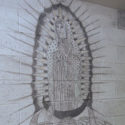
Perspectives: Thomas Eldridge
"There is a kind of spirituality I find inside Madison. Since the first time I laid eyes on one of the murals, I feel that I've been chosen to tell its story. It's like a voice, one that I must serve.... Inside Madison will be a testament to the confined human spirit in all of its anger, confusion, hope... and beauty."
Read more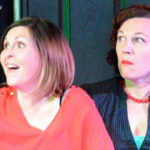
Perspectives: Amy Carpenter and Stacey Reed Hanlon
Perspectives is an on ongoing series of interviews and check-ins with recipients of our Artist Research and Development Grant (ARDG). Today we speak with 2017 ARDG recipient Amy Carpenter and her creative partner Stacey Reed Hanlon.
Read more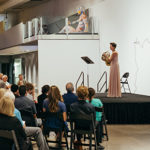
Perspectives: Johanna Lundy
Perspectives is an on ongoing series of interviews and check-ins with recipients of our Artist Research and Development Grant (ARDG). Today we speak with 2017 ARDG recipient Johanna Lundy of Tucson.
Read more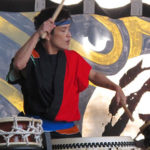
Perspectives: Karen Falkenstrom
Perspectives is an on ongoing series of interviews and check-ins with recipients of our Artist Research and Development Grant (ARDG). Today we speak with 2015 ARDG recipient Karen Falkenstrom of Tucson.
Read more

